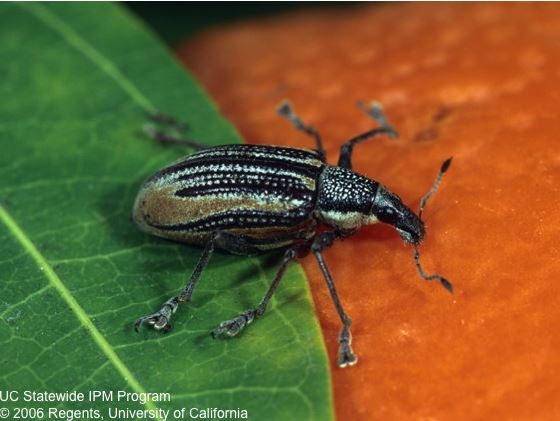Citrus plants can be hosts for invasive pests. Knowing what pests are invasive and how to avoid them is an important part of nursery production. If you work in a citrus nursery, you play an important role in looking for invasive pests and protecting the nursery—and ultimately California's citrus industry—from invasion.
Your mission, should you choose to accept it, is to prevent invasive pests and their harmful impact to agriculture. When pests or diseases are new to an area, we call them invasive. Many of the laws that are in place for citrus are to prevent new pests and diseases from establishing.
Citrus nurseries that become infested with new pests may be quarantined until the infestation is gone, preventing the plants from being moved or sold. Sometimes it requires the plants to be destroyed. Sometimes it results in the loss of a business.
You might have heard of some these invasive pests in California citrus—diaprepes root weevil, light brown apple moth, and red imported fire ant. Some invasive pests are diseases carried by an insect such as citrus variegated chlorosis spread by glassy winged sharpshooter, brown citrus aphid in Florida and Mexico making citrus tristeza even more problematic, and huanglongbing spread by Asian citrus psyllid.
Learn more about these invasive pests and how to stop their invasion by viewing an online training for workers of citrus growing in protective structures by UC Cooperative Extension Specialist Beth Grafton-Cardwell. Citrus Nursery Protective Structure Worker Training provides information on growing healthy citrus plants in structures and protecting them from common insect pests and diseases, including invasive ones in Chapter 3. You can also find on UC IPM's online training webpage, training about Asian citrus psyllid and huanglongbing for retail nursery personnel and for UC Master Gardeners.
When pests first arrive in California, an effort is made to detect them by searching the plants and by trapping them. It is important for you to be a detective and help in this effort:
- Watch for anything unusual and report anything new.
- Keep yourself and anything you work with in the protected structure clean, disinfected and free of pests.
- Keep the protective structure sound by fixing holes in screens, gaps in the structure, and unprotected vents.
- Use good practices in the nursery such as planning your day to start indoors and finish outdoors so that you don't bring outdoor pests inside.
- Don't bring in pests from other areas in budwood or fruit.
Californians can help in the fight against invasive species by learning and participating during California Invasive Species Action Week, June 2–10.
During the week, spend your lunch with us learning the latest about invasive tree killing pests, aquatic nasties like quagga mussels and nutria, and how the invasive weed/wildfire cycle is altering our ecosystems!
